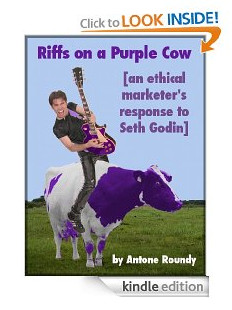When you purchase through links on our site, we may earn an affiliate commission (details)
Selling to Cold, Cool, Warm & Hot Traffic
The other day, I read where someone had commented that PPC traffic is cold traffic, and you need to sell to it differently than you would to, say, a warm mailing list. (I wish I remembered where I heard that, because I'd love to credit someone for sparking some big ideas.)
While waiting for my daughter to finish her gymnastics class today, I scribbled out a page and half of notes about how to communicate differently with website visitors based on how "warm" they're likely to be. These ideas are still a work in progress, but I thought I'd share them in case they'd benefit someone.
Don't just create a "customer avatar"...
Copywriting teachers often tell you that before you write a sales letter or even a squeeze page, you need to have a very clear picture in your mind of who you're writing to. You want to create in your mind a person who embodies the characterstics, problems, needs, etc. of your ideal customer. (This is sometimes referred to as a "customer avatar").
It occurred to me today that you really need to have at least 4 customer avatars:
- a hot prospect who knows what they want and why, but just hasn't chosen a product to fill their needs;
- a warm prospect who knows the end result they're after, but not exactly how to get it;
- a cool prospect who's looking into your niche, but isn't thinking about buying yet;
- and a cold prospect who needs what you've got as much as the others, but isn't even thinking about it yet.
In a perfect world, you'd have a large, steady stream of hot prospects, and you'd be able to ignore the rest. But this ain't a perfect world. Most of us need to be ready to sell to whoever comes along.
Talk about benefits, not features...right? Or not?
Copywriting tutorials often tell you to talk about the benefits of a product, not the features. While that's certainly key for cool and cold prospects, I suspect that hot prospects in particular already know the benefits -- if they're out to choose between alternative products to buy, they'll be comparing features.
Also, while you might talk straight benefits to cold traffic, with warm traffic, you may need to focus more on the relative benefits of your product vs. the alternatives (whether competing products or other ways to accomplish the same thing). With cold traffic, you have to focus on the question "is there anything here that's of interest to me at all?" Warmer traffic already knows they're interested in the topic -- they need to know why they should listen to what you have to say about it.
Cold traffic vs. untargetted traffic...
Before I continue, I need to make an important distinction: cold traffic is traffic that would benefit from your solution but doesn't know it and/or doesn't know you. Untargetted traffic is a mix of people who need your solution and people who don't.
Selling to untargetted traffic is incredibly difficult, because even if they're warm (they already "know, like and trust" you), you have no idea what to try to sell them. If you have a site with large amounts of untargetted traffic, you need to find a way to filter it and direct each person toward a product they'd be interested in.
Sounds difficult? Yeah. It's a problem I've struggled with for a while. I've got several websites that generate a healthy stream of untargetted traffic, and I haven't yet been able to make much off of any of them.
Engage first, then commit...
Here's what I came up with today: you have to begin by engaging them with something that requires as little commitment as possible (this also applies to cold traffic). Those who get hooked have self-selected themselves as interested in the topic of whatever your hook is. Scatter opportunities to engage on a variety of topics, and then direct people on towards products that fit each topic.
So how do you engage cold traffic? Well, you can throw up banner ads and hope that somebody will see them and click. But we all know how well that works. First you have to overcome "banner blindness", and then you have to overcome resistance to advertising.
It occurred to me today that brief surveys might do the trick. Put a little 2 or 3 question survey in a sidebar or "unblockable exit popup". If someone completes the survey, you know they have some level of interest in the topic. Use the page they see after submitting the survey to reel them in closer. For example, give them the opportunity to join a mailing list where you'll release the results of the survey or talk more about the same topic.
Better yet, use the survey questions themselves to target your visitors even more tightly. Show a different page to people based on their responses.
Not only would this technique help you filter your untargetted traffic, but it would focus their thoughts on a topic that you want them to think about. When they first arrived at your site, they may have been thinking about what color sweater to buy for their dog. Once they've taken the survey, they're thinking about the topic of the survey, and are ready for you to lead them further down the path.
That covers about half of what's in my notes. Let me know your thoughts on what I've covered so far, and if you'd like me to write more about specifically how to target different types of traffic.





February 4th, 2010 at 5:02 am
thanks for this valuable post.
I made some good experiences with surveys.
I asked visitors why they didn't order (a free trial) and gave them 6 or 7 questions to choose from (plus a free text field). Depending on their selection I sent them to a page covering this question. At the end I offered the free trial again and I got lots of conversions from these pages.
August 28th, 2010 at 12:23 pm
Great ideas here - I do have a question though on the unblockable exit pop-up. I know Google frowns on pop-ups in general, so does an exit pop-up like that have a chance to damage your SERPS?
August 28th, 2010 at 1:25 pm
Vanessa,
That's a good question. When I've read Google's comments about popups, it's sounded to me like they were talking about popup windows -- new browser windows or tabs that open up and stick around after the visitor has left your site. The "unblockable exit popups" I'm talking about are hover ads -- basically floating windows within the page itself that are made visible when someone's about to leave the page. So when they move to another page, the "popup" is gone. And they don't block the visitor from leaving the page the way JavaScript alert popups do.
I've never noticed a page of mine that had exit hover ads getting hurt in search results or AdWords. Since I'm not a Google insider, of course I can't say definitively that it couldn't happen, but it hasn't happened to me.